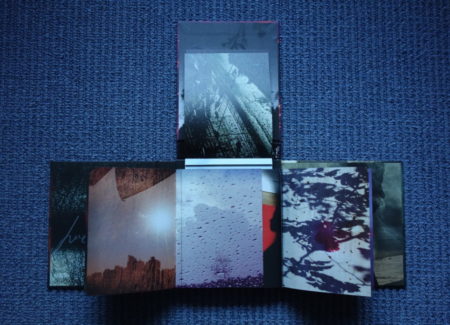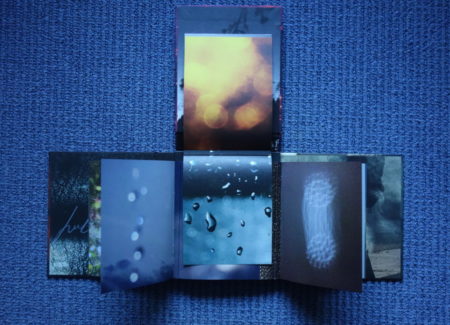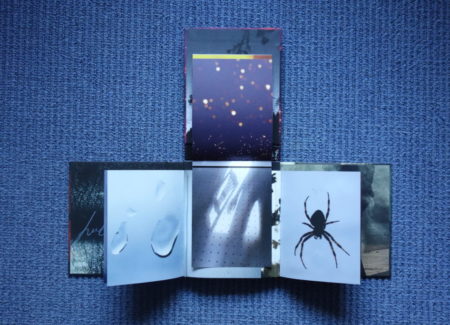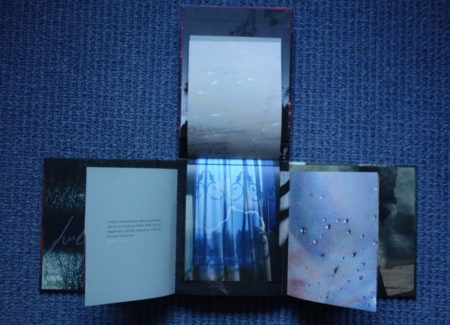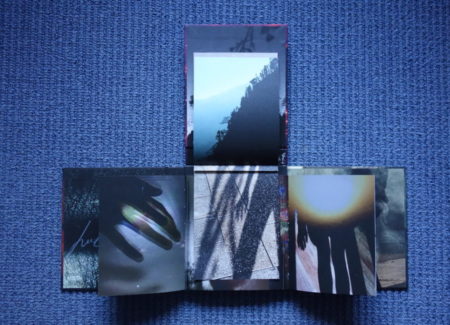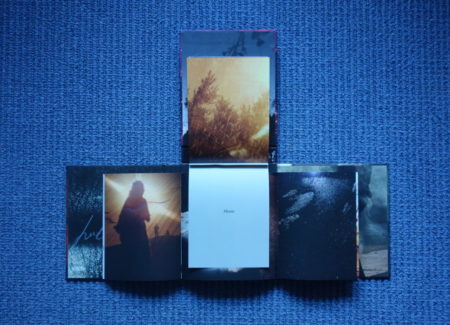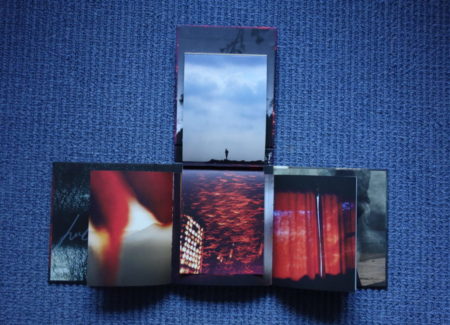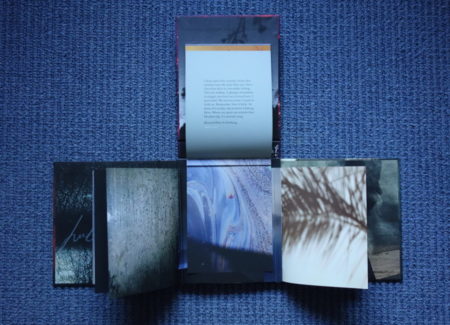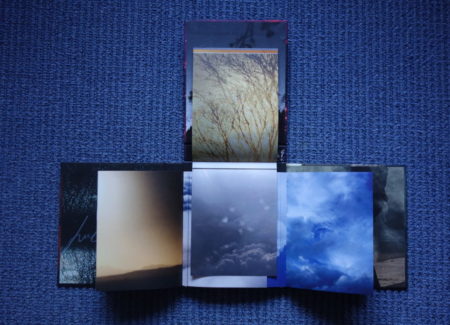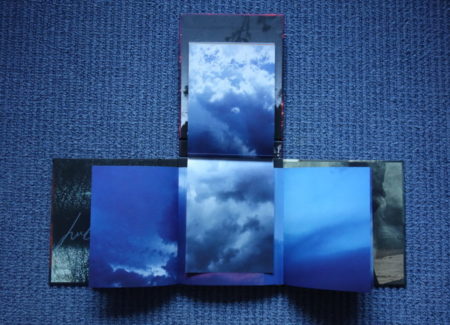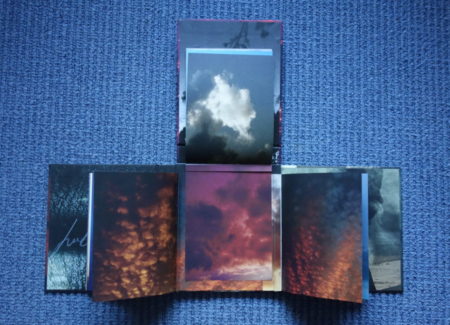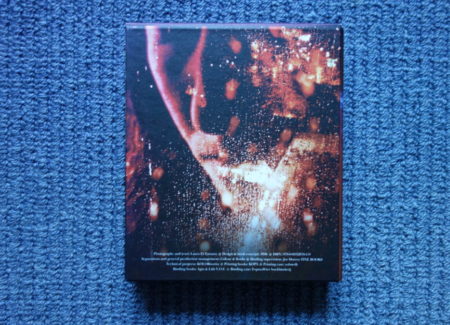JTF (just the facts): Self-published in 2017 (here). Hardcover, in three interwoven volumes opening in three directions, 190 pages, with 180 color images. Incudes short texts by the artist (the titles/topics include Slow, Numbered, Fog, Tomorrow, Time, Trapped, Moon, Fly, and Glimpse). In an edition of 500. (Cover and spread shots below.)
Comments/Context: As photobook titles go, Beyond Here Is Nothing is among the more bleakly pessimistic names that I have encountered in recent years. The cover of Laura El-Tantawy’s newest book offers these ominous words placed across the image of a narrow vertical crack in a rich red curtain, with a tiny sliver of bright light peeking through. Where some might attribute some level of promise or hope to what potentially lies beyond the confines of that curtain, El-Tantawy’s title makes it immediately clear that at least in the world we are about to enter, the deflating sense of being trapped inside is more what we can expect to encounter.
Capturing the abstract nuances of moods and emotions with a representational tool like a camera is a tricky business. Of course, most of us can make a “sad” or “lonely” picture, but the danger is that these common motifs can quickly degrade into exaggeration for effect, where melancholy slips into melodrama in just the blink of an eye. A similar failure pattern leads to mannered photographs that hit the heartstrings a little too obviously, undermining the seriousness of the intention by trying too hard to provoke the right reaction. The artfully poetic can become precious mystical nonsense faster than we like to admit.
In El-Tantawy’s case, her interest in this darker range of interior moods comes from a deep seated sense of personal rootlessness. As an Egyptian living in London, following the pathways of an international artist, El-Tantawy’s definition of “home” is particularly fluid, and armed with her iPhone, she has attempted to capture her particular state of continual uncertainty. For the most part, her images are far from literal, instead giving us an expressionistic sense of the fleeting moments of her life where meditative loneliness starts to fill in the empty spaces.
But almost before we can begin to engage with the photographs, Beyond Here Is Nothing boldly confronts us with its radical construction. The “book” is unconventionally hinged on three sides, effectively interleaving the pages of three separate books into a single unified whole. To experience the images, we have to iteratively unfold each side, creating a left-right-center rhythm of peeling back, each extended spread a conglomeration of four full bleed pages that interact and intermingle.
For the most part, this construction feels both wildly innovative and well matched to the artistic direction of this project. Because of the way the pages unfold, the images undulate along, seeming to move back and forth in relation to each other in a circulating flow. The progression is decidedly one way, but the page turns have a lilting quality, where photographic ideas are harmonized and refrains are allowed to build.
The one downside to this complexity is that I had the constant sense that I might be “doing it wrong”, that unfolding the pages in the wrong order might break whatever highly calibrated sequencing and visual echoing El-Tantawy had so carefully planned. So I attentively followed the page turns as meticulously as I could, my efforts not to screw up the pace of the unfolding (and refolding when I was done) distracting me a bit from enjoying the entire integrated experience.
In general, El-Tantawy’s photographs edge toward the impressionstic, where recognizable representation slowly dissolves into the abstraction of surfaces, textures, and colors. When we see people (perhaps even the artist herself in some cases), they are never specific, always silhouettes or shadows cast on walls or seen through windows. It’s as if the connections to these other humans are tenuous at best, their cutout forms ever fleeting, their personalities indistinct. In one series, the shadows of hands and legs become surreally elongated, reaching and grasping but never quite touching.
Wetness is another common theme, with plenty of moistened and dripped surfaces to be explored. Glass is variously fogged, misted, and covered in droplets, with cold grey clouds and rain made soft in the distance. Dark wet trees emerge from the watery scenes like views from Josef Sudek’s studio, but the warm homey comfort of Sudek’s world is replaced by something more foreboding, the dreary weather deepening the sense of quiet brooding solitude. Even the visual delights of flares of light through drips, rainbow oil slicks, and skyward reflections in puddles have a muted feeling of observant resignation.
The rhythms of the imagery bring us back again and again to patterns of watchful loneliness. El-Tantawy sees spiders and dragonflies, a bird perched behind pebbled glass, and tree branches that soar overhead or intrude into view, but their joys are quizzical more than exuberant. Pin pricks of light are turned into spots and auras, the dark night twinkles with stars, and curtains and veils screen our view with gauzy textures that prevent us from seeing the world clearly. Empty hills recede into the metaphorical distance, with lone figures dwarfed by the immensity of the space. At the end, smoke and fog give way to a series of soaring clouded skies, the colored vistas and sunsets ranging from hazy yellow and cool blue to enveloping grey and blood red. And through it all, El-Tantawy weaves in diaristic fragments of text, like short journal entries or impromptu poems that find her meditating on the lingering absences in her life and how she interprets them.
Beyond Here Is Nothing is a surprisingly experiential photographic project, with evolving reactions and stories that wander though its pages. In attempting to capture the subtle nature of outsider loneliness, it moves like a restless ghost, searching, looking, and returning to touchstone experiences and color impressions, letting the essences of sorrow and fear linger until they resolve or dissipate. Seen together, in the context of the clever interleaved construction, El-Tantawy’s photographs coalesce into a varied emotional landscape, without becoming maudlin or despairing. She successfully invites into a very personal sense of her self, where every passing glance is infused with a tint of hollow absence.
Collector’s POV: Laura El-Tantawy does not appear to have consistent gallery representation at this time. Beyond Here Is Nothing was recently presented as a gallery show at Seen Fifteen in London (here). The artist’s website is linked in the sidebar above, for those collectors interested in following up directly.


